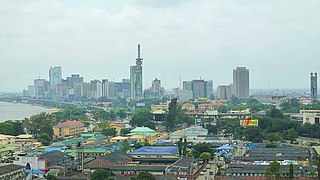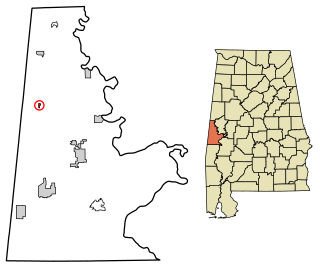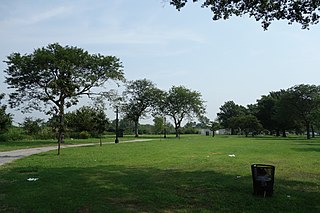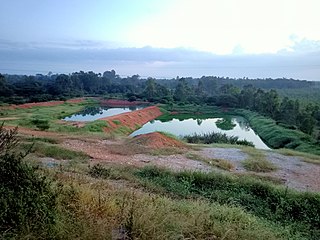Related Research Articles

Lagos or Lagos City is the most populous city in Nigeria, with an estimated population of 21 million in 2015. Lagos is the most populous urban area in Africa. Lagos was the national capital of Nigeria until December 1991 following the government's decision to move their capital to Abuja in the centre of the country. Lagos is a major African financial centre and is the economic hub of Lagos State and Nigeria at large. The city has a significant influence on commerce, entertainment, technology, education, politics, tourism, art, and fashion in Africa. Lagos is also among the top ten of the world's fastest-growing cities and urban areas. The megacity has the fourth-highest GDP in Africa and houses one of the largest and busiest seaports on the continent. Due to the large urban population and port traffic volumes, Lagos is classified as a Medium-Port Megacity.

Emelle is a town in Sumter County, Alabama, United States. It was named after the daughters of the man who donated the land for the town. The town was started in the 19th century but not incorporated until 1981. The daughters of the man who donated were named Emma Dial and Ella Dial, so he combined the two names to create Emelle. Emelle was famous for its great cotton. The first mayor of Emelle was James Dailey. He served two terms. The current mayor is Roy Willingham Sr. The population was 32 at the 2020 census.

A landfill site, also known as a tip, dump, rubbish dump, garbage dump, trash dump, or dumping ground, is a site for the disposal of waste materials. Landfill is the oldest and most common form of waste disposal, although the systematic burial of the waste with daily, intermediate and final covers only began in the 1940s. In the past, refuse was simply left in piles or thrown into pits; in archeology this is known as a midden.

Toxic waste is any unwanted material in all forms that can cause harm. Mostly generated by industry, consumer products like televisions, computers, and phones contain toxic chemicals that can pollute the air and contaminate soil and water. Disposing of such waste is a major public health issue.

The Fresh Kills Landfill was a landfill covering 2,200 acres (890 ha) in the New York City borough of Staten Island in the United States. The name comes from the landfill's location along the banks of the Fresh Kills estuary in western Staten Island.

Land reclamation, usually known as reclamation, and also known as land fill, is the process of creating new land from oceans, seas, riverbeds or lake beds. The land reclaimed is known as reclamation ground,reclaimed land, or land fill.

Ariel Sharon Park is an environmental park along the lines of Ayalon river, in the area between Ben Gurion Airport and Highway 20. The area is 8.5 square kilometers big, and was intended to be the "green lung" of the southern part of Gush Dan metropolin. The park was established on the former Hiriya waste dump located southeast of Tel Aviv, Israel, the Shalem farm, Mikveh Israel village and the Menachem Begin Park. After accumulating 25 million tons of waste, the Hiriya facility was shut down in August 1998. Hiriya is visible on approach into Ben Gurion International Airport as a flat-topped hill. Three recycling facilities have been established at the foot of the mountain: a waste separation center, a green waste facility that produces mulch and a building materials recycling plant. The waste dump and its surrounding area have been renovated into a large park that is still under construction.

Armenia is underdeveloped in its waste management and recycling activities.

The Otamiri River is one of the main rivers in Imo State, Nigeria. The river takes its name from Ota Miri, a deity who owns all the waters that are called by his name, and who is often the dominating god of Mbari houses. The river runs south from Egbu past Owerri and through Nekede, Ihiagwa, Eziobodo, Olokwu Umuisi, Mgbirichi and Umuagwo to Ozuzu in Etche, in the Rivers State, from where it flows to the Atlantic Ocean. The length of the river from its source to its confluence at Emeabiam with the Uramiriukwa River is 30 kilometres (19 mi).
The Ringwood Mines landfill site is a 500-acre former iron mining site located in the borough of Ringwood, New Jersey. From 1967 to 1980, the Ford Motor Company dumped hazardous waste on this land, which negatively affected the health and properties of Ramapough Mountain Indians. This led to Mann V. Ford, a 1997 lawsuit between Ramapough Lenape Tribe's lawsuit of the Ford Motor Company.

It is estimated that 290 million tonnes of waste was produced in the United Kingdom in 2008 but volumes are declining. In 2012 municipal solid waste generation was almost 30 million tonnes, according to Waste Atlas Platform.
The Newby Island Landfill (NISL) is one of the largest active landfills on the shores of the San Francisco Bay. It is located in Santa Clara County, California in the United States. The site is located within the city limits of San Jose, California at the western terminus of Dixon Landing Road. The address is 1601 Dixon Landing Road, Milpitas. Although the address and public street access to the site are both in the City of Milpitas, the landfill property is entirely within the City of San Jose. Newby Island Landfill has a length of 5.07 km (3.15 mi). It is located West of the City of Milpitas near Dixon Landing Road and Interstate 880. It is the terminus for waste for all of San Jose (62%), Santa Clara (14%), Milpitas (10%), Cupertino (5%), Los Altos (2%) and other cities (7%). The 342-acre pile is currently permitted to operate until 2041 and may extend up to 245 feet. The landfill is an island surrounded by a levee which keeps its runoff from directly entering the bay, and the water that drains from it is treated in the landfill's own treatment plant. Electricity for the landfill is generated by burning the methane collected from the decomposition of the waste. Dried sewage sludge from the nearby San José–Santa Clara Regional Wastewater Facility is the material used as cover, mixed in with the trash, blending San Jose's waste streams. It is operated by Republic Services (Republic), which, along with Waste Management Incorporated, transports and disposes of most of the household trash in the United States.

Spring Creek Park is a public park along the Jamaica Bay shoreline between the neighborhoods of Howard Beach, Queens, and Spring Creek, Brooklyn, in New York City. Created on landfilled former marshland, the park is mostly an undeveloped nature preserve, with only small portions accessible to the public for recreation.

Edgemere Landfill is a former municipal landfill located in Edgemere on the Rockaway peninsula in Queens, New York City. It is located on a man-made peninsula on the Jamaica Bay shoreline, at the eastern end of the Rockaway peninsula. A portion of the site is currently open to the public as Rockaway Community Park. The entire site is owned by the New York City Department of Parks and Recreation.

Shirley Chisholm State Park is a 407-acre (1.65 km2) state park in southeastern Brooklyn, New York City. It is bound by Belt Parkway and Spring Creek Park to the north and Jamaica Bay to the south, situated atop the former Pennsylvania Avenue and Fountain Avenue Landfills. The first sections of the park opened in 2019.


New York City's waste management system is a refuse removal system primarily run by the New York City Department of Sanitation (DSNY). The department maintains the waste collection infrastructure and hires public and private contractors who remove the city's waste. For the city's population of more than eight million, The DSNY collects approximately eleven thousand tons a day of garbage, including compostable material and recycling.
The Clark Sanitary Landfill is a landfill at the Clark Special Economic Zone in Capas, Tarlac managed and operated by the Metro Clark Waste Management Corp.. It stores and process waste from the Clark area as well as other areas in Central and Northern Luzon.
Electrical and electronic equipment (EEE) waste, or e-waste, is illegally brought into African states every year. A minimum of 250,000 metric tons of e-waste comes into the continent, and according to the Swiss Federal Laboratories for Materials Science and Technology, the majority of it in West Africa enters from Europe. Developed countries commodify underdeveloped African states as dumping grounds for their e-waste, and due to poor regulations and a lack of enforcement institutions, illegal dumping is promoted. Currently, the largest e-waste dumping site in Africa is Agbogbloshie in Ghana. While states like Nigeria do not contain e-waste sites as concentrated as Agbogbloshie, they do have several small sites.
References
- ↑ Christine Jenkins (2011-02-19). "An Incredible Satellite Tour Of 15 Trash Dumps That Are Bigger Than Towns". Business Insider. Retrieved 2012-11-13.
- ↑ "News Feature - Olusosun, Lagos Suburb in the eye of filthy storm: A Government's Course; A People's Curse". Africanoutlookonline.com. Retrieved 2012-11-13.
- ↑ Freeman, Andrew (2012-05-25). "7 of the Largest Landfills in the World". Takepart.com. Retrieved 2012-11-13.
- ↑ "The Big Picture: climate change | Environment | The Observer". Guardian. 2008-03-23. Retrieved 2012-11-13.
- ↑ "Olusosun: Intriguing ways of seeking wealth in refuse heaps". Vanguardngr.com. 2012-06-27. Retrieved 2012-11-13.
